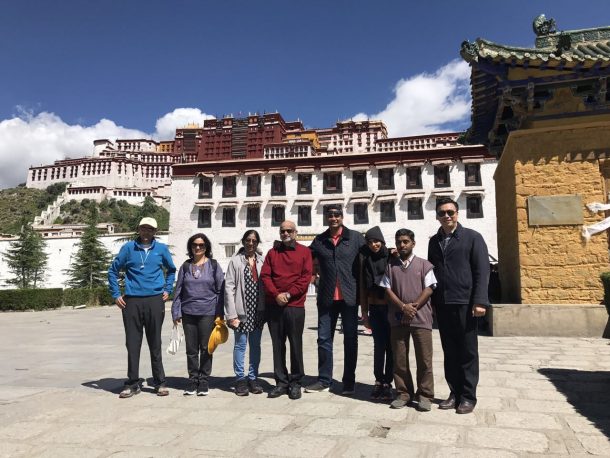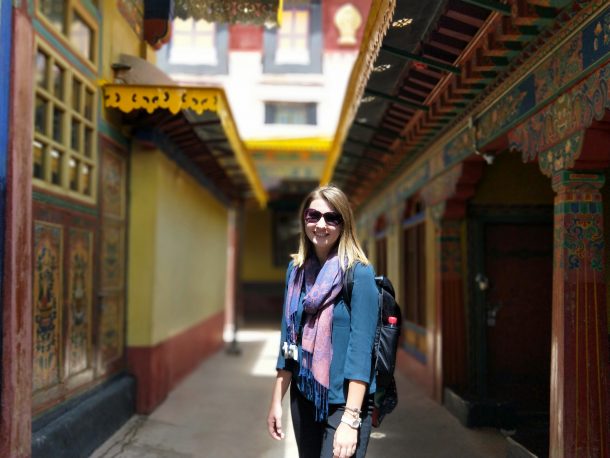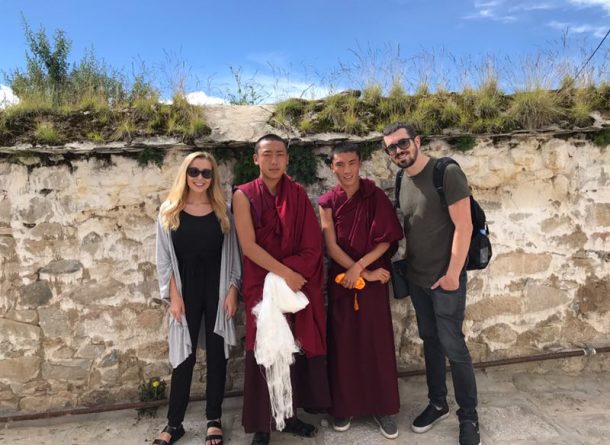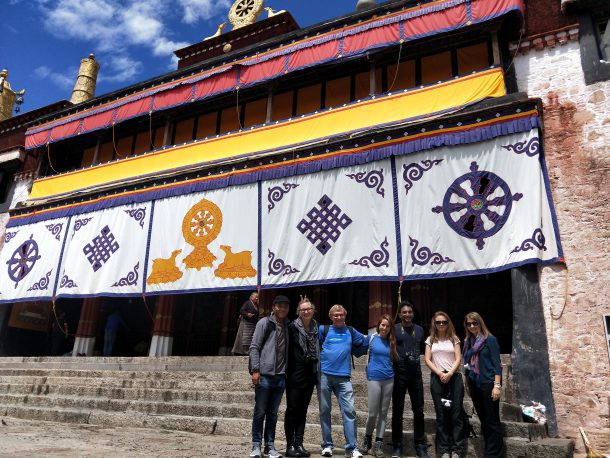
How to Visit a Monastery in Tibet

Explore Tibet guests at the Potala Palace, in Lhasa
An unavoidable and integral part of any tour to Tibet is visiting monasteries – the religious center of Tibetan life and culture. But for people who are unfamiliar with Tibetan Buddhist customs, it can be overwhelming and even a little intimidating the first time you walk into a monastery and wonder “What are all these people doing?” Well, fear not, read on, and find out some tips and rules for how to visit a monastery in Tibet.
Visiting a monastery or a temple is referred to in the Tibetan language as “Cho-jel”, meaning “To meet Dharma/Religion”. It’s an essential practice for Tibetan Buddhists, and especially important to do on particular auspicious days: the 8th, 10th, 15th, 25th, 29th, and 30th of each Tibetan lunar month.
Here are five tips for visiting monasteries and temples in Tibet, to help you understand what is happening around you, and to enable you to be a part of the practices too.
Table of Contents
1. Walk clockwise
In Tibetan Buddhism, clockwise is the “sacred direction”: patterns and designs feature clockwise-rotating swastika, shells with a clockwise-turning coil, and prayer wheels should always be spun clockwise. To do the opposite or go in the opposite direction implies that you follow Bon, Tibet’s ancient pre-Buddhist religion. Bon and Buddhism share many holy sites and practices, but a visual distinction between the two can be made depending which direction their followers walk.
When inside a monastery, you should always visit the rooms in a clockwise direction, starting to the left each time.
2. Remove hats, sunglasses
The top of the head is a holy part of the body, according to Tibetan custom, so to show your respect for the Buddhas inside the monastery hats and sunglasses should be removed before entering. Some chapels will require you to remove your shoes too, but this is less common.
3. Make offerings
There are many different types of offering that can be made in a temple: from simple one yuan note offerings in front of each Buddha, to spoonfuls of butter for the lamps, to white silk scarves (“kata”) for the main statues. Outside monasteries you may see people standing by with stacks of notes in their hand, here you can exchange a larger denomination (5 yuan or 10 yuan) note for a stack of ones, or a one yuan note for a stack of jiao (equivalent of ten cents). Do as the locals do and offer one of these small notes in front of each statue – the money goes into supporting the monastery’s maintenance. White scarves can be bought either outside the monastery or sometimes right in front of the statues to which you will offer them (such as in the Jokhang), and cost between two yuan to twenty yuan depending on the quality and your bargaining skills.
4. Offer prostrations or prayers
A common sight both inside and outside Tibetan monasteries is people offering prostrations – a full extension of their body face down on the ground in front of a shrine or statue (or sometimes around one, as a kora). This is a full-body act of devotion, showing utmost respect for the Buddha and dharma by literally putting yourself below them. Prayers are most common in the form of mantra, such as the famous “Om Mani Padme Hung” mantra of Chenriseg, the Bodhisattva of Compassion.
5. Take a picnic
Many Tibetan people will finish their trip to a monastery with a picnic or a relaxing stop at the local teahouse. Picnicking is a national sport in Tibet, and you’ll see families fully prepared with blankets, huge flasks of hot tea, multiple dishes of meat and vegetables, and sometimes games for entertainment. The monasteries outside the city are the best for picnicking such as Drak Yerpa, Ganden, and Tsurphu.
6. Bonus. Meet the Rinpoche
Many monasteries have a resident Rinpoche, Tulku, or Abbot whom one can request blessing from if they are available. When meeting a Rinpoche you can offer money or kata, similar to the offerings you would make to a statue of the Buddha, and it’s generally expected that you will also offer prostrations upon first entering the room. The Rinpoche may give you a blessed cotton string, medicine, or a kata in return.

An Explore Tibet guest visits Drepung Monastery

Explore Tibet guests meet monks at Drepung Monastery

Explore Tibet guests visit Drepung Monastery
Recent Posts
The Ultimate Guide to Tibet Tours, Travel, and Trekking Adventures
How to Explore Tibetan Culture
Exploring Lhasa:The Heart of Tibet
All Categories
- About Tibet
- book a Tibet tour
- Buddhism Practice
- Budget Tour
- China-Tibet Train
- Customized Tibet tour
- Historical Sites
- Hot Springs in Tibet
- News
- Photography in Tibet
- Tibet attraction
- Tibet Group Visa
- Tibet Motorcycle Tour
- Tibet Small Group Tours
- Tibet Tours and Tibetan Tour Guide
- Tibet Train
- Tibet Travel FAQs
- Tibet Travel Information
- Tibet Travel News
- Tibet Travel Permit Update
- Tibet Travel Prices Rises
- Tibet Trek
- Tibet Trekking Tour
- Tibet weather and climate
- Tibet Wildlife animals
- Tibet Winter Tour
- Tibetan Buddhism
- Tibetan Cultural Features
- Tibetan Culture and Poeple
- Tibetan Festivals
- What to see in Tibet



